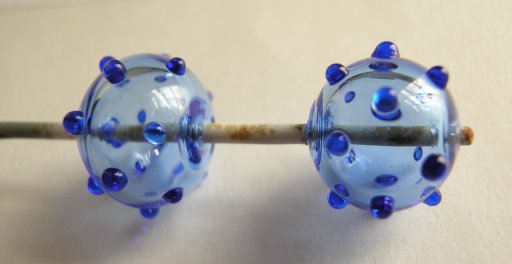The response to someone trumpeting this particular skill might reasonably be a big, fat, yawn. Or a “how nice for you, but you do know rubbing a bead on a torchtop marver for 3–4 seconds is not really that big a deal.”
However, for glasses, e.g. dark aquamarine, that are prone to forming a scum when marvered on graphite, this approach eliminates that unsightly line of tiny bubbles along the equator. (For all I know marvering on brass may achieve the same effect with considerably less effort; I know some colors react differently—perhaps I ought to mount a strip of brass on my torch...)
Ok, so you'd actually like to do this yourself. Oh joy, the pleasure of attempting to explain something when half asleep. (But I'm so happy my class is over, I had to make a post!) Um...you do need to lay down your coils evenly and smoothly. If you're great, you make two halves that meet perfectly in the middle. (I've actually managed to do this. Mebbe even three times.) If you're only good, the second half ends up (usually) being larger than the first, flaring past it. Spin the bead faster to pull the coils very thin during this overlapping part, then tilt the bead downward to encourage this wider, thinner lip to lap and melt into the first, paying special attention to any pinholes that form. (Flash them to melt ’em shut.)
Well, that's today's earthshattering revelation. We will return you to the regularly scheduled helpings of angst, meandering mumblings and incoherent rants next time;)
file created 23apr07
Unless otherwise noted, text, image and objects depicted therein copyright 1996--present sylvus tarn.
Sylvus Tarn